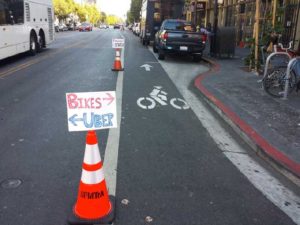 A great deal of litigation, in California and elsewhere has surrounded the issue of whether ride-service drivers should be construed as employees (or agents) of their “platform,” thereby rendering the platform or service vicariously liable for a driver’s negligently caused vehicular accidents.
A great deal of litigation, in California and elsewhere has surrounded the issue of whether ride-service drivers should be construed as employees (or agents) of their “platform,” thereby rendering the platform or service vicariously liable for a driver’s negligently caused vehicular accidents.
Effective July 1, 2015, AB 2993 became law in California, adding Sections 5430 et seq. to the Public Utilities Code. Under these statutes, the ride-sharing platform (called a “transportation network company”) must insure the driver while he or she is carrying a passenger for hire. In addition, the platform’s statutorily required one million dollar limit insurance coverage for such a loss is primary: “Transportation network company insurance shall be primary and in the amount of one million dollars ($1,000,000) for death, personal injury, and property damage.” Pub. Util. Code § 5433. Thus, in cases where an injured plaintiff’s likely damages recovery is one million dollars or less, this statutory insurance requirement negates the need to resolve the issue of the legal status of the driver: there is enough insurance coverage to cover the loss.
But in California personal injury cases where a plaintiff’s potential damages recovery exceeds that million dollar insurance threshold, legal issues concerning the ride-sharing platform’s potential vicarious liability may still arise. In such instances, the first thing to note is that the party seeking to avoid an employment relationship has the burden of proving that persons whose services they retain are not employees. S. G. Borello & Sons, Inc. v. Department of Industrial Relations (1989) 48 Cal.3d 341, 349.

(Source: SFMTrA, via Twitter)
The “right to control” test is the primary determining factor: “California decisions applying such statutes uniformly declare that ‘[t]he principal test of an employment relationship is whether the person to whom service is rendered has the right to control the manner and means of accomplishing the result desired…’” Id. at 350 (internal citation omitted). Beyond this “right to control” analysis, courts also look at a number of other factors in order to determine whether one is an employee of another. These factors include “(a) whether the one performing services is engaged in a distinct occupation or business; (b) the kind of occupation, with reference to whether, in the locality, the work is usually done under the direction of the principal or by a specialist without supervision; (c) the skill required in the particular occupation; (d) whether the principal or the worker supplies the instrumentalities, tools, and the place of work for the person doing the work; (e) the length of time for which the services are to be performed; (f) the method of payment, whether by the time or by the job; (g) whether or not the work is a part of the regular business of the principal; and (h) whether or not the parties believe they are creating the relationship of employer-employee.” S. G. Borello & Sons, Inc., 48 Cal.3d at 351.
While no appellate court, to date, has issued a dispositive ruling as to a platform’s vicarious liability for acts of its driver in California, the California Labor Commissioner has considered the issue of a driver’s employee status, after analysis of the factors listed above, as to a driver for the largest platform (Uber) in a wage and hour case. See order included in the file in Uber v. Berwick, Note particularly at page 8 of the Labor Commissioner’s Order there, the conclusion finding that there was indeed a right to control on the part of the ride-sharing platform over its driver because: “By obtaining the clients in need of the service and providing the workers to conduct it, Defendants retained all necessary control over the operation as a whole.”
Additionally, counsel should not overlook the fact that a plaintiff need not necessarily prevail on the issue of a ride-sharing driver’s employment status in order to obtain a finding of vicarious liability; a service can also be legally responsible for its driver’s conduct if he or she was its agent. The difference in taking the approach of “agency” rather than “employment” is that a driver’s status as an independent contractor is acknowledged in the agency query, rather than contested when employment is at issue.
“An agent is one who represents another, called the principal, in dealing with third persons.” Civ. Code § 2295. Agency may be implied from the circumstances and conduct of the parties. Michelson v. Hamada (1994) 29 Cal.App.4th 1566, 157. Where an agency relationship exists: “[A] principal is responsible to third persons for the negligence of his agent in the transaction of the business of the agency…” Civ. Code § 2338. The California Supreme Court has summarized: “Civil Code section 2338, which has been termed a codification of the respondeat superior doctrine [citation omitted]…makes the principal liable for negligent and ‘wrongful’ acts committed by the agent ‘in and as part of the transaction of such [agency] business.’” Lisa M. v. Henry Mayo Newhall Memorial Hospital (1995) 12 Cal.4th 291, fn. 2 (brackets in original).
An independent contractor (such as a ride-sharing company’s driver) might thus be the agent of the person or entity with whom he or she contracts. See, City of Los Angeles v. Meyers Bros. Parking System, Inc. (1975) 54 Cal.App.3d 135, 138 (emphasis in original): “Agency and independent contractorship are not necessarily mutually exclusive legal categories… In other words, an agent may also be an independent contractor. [Citation omitted.]”
What factors drive the analysis of whether or not there is agency, when that issue is contested? As CACI 3704 notes, the relevant factors analytically are the same as those that dictate the result of employee/contractor analysis of vicarious liability. CACI 3704 further states that the: “most important factor is whether [the ride sharing company] had the right to control how [the driver] performed the work…” Where the platform at issue has extensive requirements for its drivers, controlling almost every aspect of the performance of the driver’s work, a finding of agency is more likely.
Relevant facts in a particular case might include any or all of the following. Before drivers are permitted on some platforms, must they undergo a professional third-party background check and/or a DMV check? Will drivers be disqualified if the background checks reveal a history of criminal convictions? Such investigations, it can be argued, are indicia of right to control.
Most platforms require that drivers have a smart phone capable of running their software.
The platform supplies the software, or “app,” that runs its vehicle-for-hire program, often including a special, proprietary GPS function. Most require drivers to use their map function to ensure the platform knows where its drivers are at any time while en route to drop-off locations. Generally, customers must also use a designated app to request a platform’s driver. Once a customer requests a ride, the app and GPS system connect the driver’s and customer’s location, so each knows where the other is located in real-time. Once a driver picks up a customer, the platform can track and monitor the location of the driver and customer. As soon as a customer is dropped off, the app registers drivers as free to pick up another customer. Such control by the ride-service of the process by which the customer is obtained and tracked can further be argued as indicia of control.
A ride-sharing service might also define the suitability of driver’s vehicles, and what they look like, such as: number of doors; designated age; good running condition and a minimum number of seats. Consider as well whether those applying to be a driver must obtain mechanical inspection of their vehicles by the platform or its designee. Some platforms supply drivers with distinctive trade dress (decals or emblems) recognizable by users; when “in driver mode,” drivers may be required to display one emblem on the front windshield and one on the rear windshield, and to display these emblems in a certain manner. All of these facts might be argued to show a right to control.
The ride-service may also provide drivers with IDs allowing them to wait in a designated location near airport terminals, where taxis and limos also wait. Drivers may further be instructed on a myriad of other details that might potentially point to the platform’s right to control, including: how often drivers must wash and vacuum their cars; whether drivers must maintain available trunk space; and a prohibition on having friends join them while they are driving on the platform. Such factual ties between the driver’s day-to-day vehicle operation and the ride-sharing platform may help to establish agency or employment.
The most compelling indicia of right to control, or the absence of it, may be set forth in the contractual relationship in force between the driver and the platform, which should be obtained in discovery. For example, such a document may provide that the platform has the right to “terminate” a driver at any time, for any or no reason, without explanation, effective upon sending written or email notice. Such terms of agreement are important because: “The right to terminate the service at any time is a strong circumstance tending to show the right to control.” Villanazul v. City of Los Angeles (1951) 37 Cal.2d 718, 721. See also, Ayala v. Antelope Valley Newspapers, Inc. (2014) 59 Cal.4th 522, 531 (internal citation omitted): “Perhaps the strongest evidence of the right to control is whether the hirer can discharge the worker without cause, because ‘[t]he power of the principal to terminate the services of the agent gives him the means of controlling the agent’s activities.’”
It might further be argued that the statutory scheme recognizing the primary responsibility of the “transportation network company” for third party damages and losses incurred in the course of the business enterprise itself points to a finding of agency or employment. Cf., Phelps v. 3PD, Inc. (D. Or. 2009) 261 F.R.D. 548, 556 (certifying a class of truck drivers and noting purchase of insurance coverage as showing right of control: “Several provisions in the driver agreements, which are common to all drivers…are relevant to the right to control issue. These provisions include standards of service…purchase of insurance coverage…placement of marks or logos on trucks…and termination.”).
Finally, a ride-sharing platform’s very business model, obtaining passengers in need of transportation and providing drivers to meet that need, might be deemed to show “pervasive control” over the operation as a whole. See, as illustrative in this regard, Yellow Cab Cooperative, Inc. v. Workers’ Comp. Appeals Bd. (1991) 226 Cal.App.3d 1288, 1295, citing to Borello, supra.
In larger California personal injury cases, where a driver’s potential status as employee or agent of a ride-service platform remains at issue, all of these factual queries, and many others, will be important to the court’s determination of the outcome.
Only time will tell how this issue, a critical one in application of tort law to this “gig economy,” will be resolved by the appellate courts.
